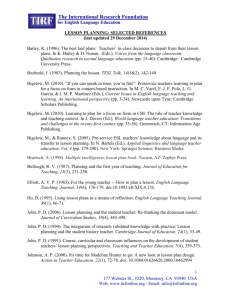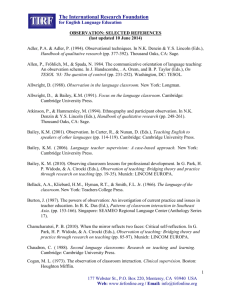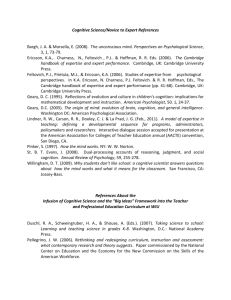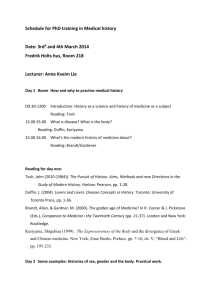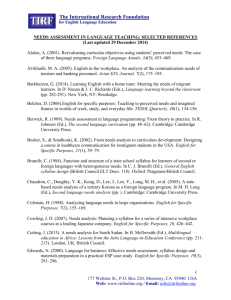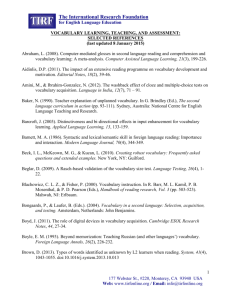Observation Selected Reference List
advertisement
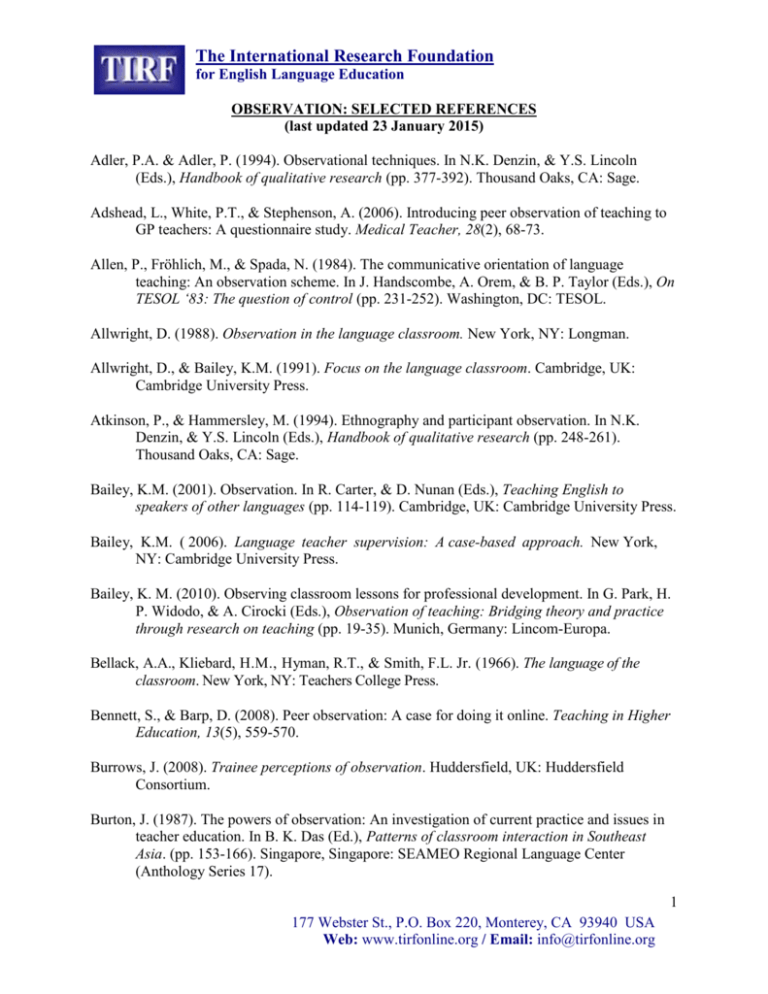
The International Research Foundation for English Language Education OBSERVATION: SELECTED REFERENCES (last updated 23 January 2015) Adler, P.A. & Adler, P. (1994). Observational techniques. In N.K. Denzin, & Y.S. Lincoln (Eds.), Handbook of qualitative research (pp. 377-392). Thousand Oaks, CA: Sage. Adshead, L., White, P.T., & Stephenson, A. (2006). Introducing peer observation of teaching to GP teachers: A questionnaire study. Medical Teacher, 28(2), 68-73. Allen, P., Fröhlich, M., & Spada, N. (1984). The communicative orientation of language teaching: An observation scheme. In J. Handscombe, A. Orem, & B. P. Taylor (Eds.), On TESOL ‘83: The question of control (pp. 231-252). Washington, DC: TESOL. Allwright, D. (1988). Observation in the language classroom. New York, NY: Longman. Allwright, D., & Bailey, K.M. (1991). Focus on the language classroom. Cambridge, UK: Cambridge University Press. Atkinson, P., & Hammersley, M. (1994). Ethnography and participant observation. In N.K. Denzin, & Y.S. Lincoln (Eds.), Handbook of qualitative research (pp. 248-261). Thousand Oaks, CA: Sage. Bailey, K.M. (2001). Observation. In R. Carter, & D. Nunan (Eds.), Teaching English to speakers of other languages (pp. 114-119). Cambridge, UK: Cambridge University Press. Bailey, K.M. ( 2006). Language teacher supervision: A case-based approach. New York, NY: Cambridge University Press. Bailey, K. M. (2010). Observing classroom lessons for professional development. In G. Park, H. P. Widodo, & A. Cirocki (Eds.), Observation of teaching: Bridging theory and practice through research on teaching (pp. 19-35). Munich, Germany: Lincom-Europa. Bellack, A.A., Kliebard, H.M., Hyman, R.T., & Smith, F.L. Jr. (1966). The language of the classroom. New York, NY: Teachers College Press. Bennett, S., & Barp, D. (2008). Peer observation: A case for doing it online. Teaching in Higher Education, 13(5), 559-570. Burrows, J. (2008). Trainee perceptions of observation. Huddersfield, UK: Huddersfield Consortium. Burton, J. (1987). The powers of observation: An investigation of current practice and issues in teacher education. In B. K. Das (Ed.), Patterns of classroom interaction in Southeast Asia. (pp. 153-166). Singapore, Singapore: SEAMEO Regional Language Center (Anthology Series 17). 1 177 Webster St., P.O. Box 220, Monterey, CA 93940 USA Web: www.tirfonline.org / Email: info@tirfonline.org The International Research Foundation for English Language Education Chamcharatsri, P. B. (2010). When the mirror reflects two faces: Critical self-reflection. In G. Park, H. P. Widodo, & A. Cirocki (Eds.), Observation of teaching: Bridging theory and practice through research on teaching (pp. 85-97). Munich, Germany: Lincom-Europa. Chaudron, C. ( 1988). Second language classrooms: Research on teaching and learning. Cambridge, UK: Cambridge University Press. Cockburn, J. (2005). Perspectives and politics of classroom observation. Research in PostCompulsory Education, 10(3), 373-388. Cogan, M. (1973). Clinical supervision. Boston, MA: Houghton Mifflin. Cosh, J. (1999). Peer observation: A reflective model. ELT Journal, 53(1), 22-27. Croll, P. (1986). Systematic classroom observation. London, UK: Falmer. Day, R. R. (1990). Teacher observation in second language teacher education. In J. C. Richards, & D. Nunan (Eds.), Second language teacher education (pp. 43-61). New York, NY: Cambridge University Press. Dyke, M., Harding, A., & Liddon, S. (2008). How can online observation support the assessment and feedback, on classroom performance, to trainee teachers at a distance and in real time? Journal of Further and Higher Education, 32(1), 37-46. Elghannam, A. (1997). Peer observation: Concepts and practices. Dialog on Language Instruction, 12 (1/2), 41-45. Emerson, R.M., Fretz, R.I. & Shaw, L.L. (2001). Participant observation and fieldnotes. In P. Atkinson, A. Coffey, S. Delamont, J. Lofland, & L. Lofland (Eds.), Handbook of ethnography (pp. 352-368). London, UK: Sage. Fanselow, J. (1977). Beyond ‘Rashomon’– Conceptualizing and describing the teaching act. TESOL Quarterly, 11(1), 17-39. Fanselow, J. (1987). Breaking rules: Generating and exploring alternatives in language teaching. New York, NY: Longman. Fanselow, J. (1988). “Let's see”: Contrasting conversations about teaching. TESOL Quarterly, 22(1), 113-130. Fanselow, J. (1988). “Let's see”: Contrasting conversations about teaching. In J.C. Richards, & D. Nunan (Eds.), Second language teacher education (pp. 182-199). New York, NY: Cambridge University Press. Fawcett, M. (1996). Learning through child observation. London, UK: Jessica Kingsley. 2 177 Webster St., P.O. Box 220, Monterey, CA 93940 USA Web: www.tirfonline.org / Email: info@tirfonline.org The International Research Foundation for English Language Education Flaitz, J. (1993). Two new observation report formats for teachers in training. English Teaching Forum, 31(4), 22-25. Flanders, N. A. (1970). Analyzing teaching behavior. Reading, MA: Addison-Wesley. Flanders, N. A. (1976). Interaction analysis and clinical supervision. Journal of Research and Development in Education, 9, 47-57. Foster, P. (1996). Observing schools—A methodological guide. London, UK: Paul Chapman Publishing. Freeman, D. (1982). Observing teachers: Three approaches to in-service training and development. TESOL Quarterly, 16(1), 21-28. Fröhlich, M., Spada, N., & Allen, P. (1985). Differences in the communicative orientation of L2 classrooms. TESOL Quarterly, 19(1), 27-57. Fullerton, H. (2003). Observation of teaching. In H. Fry, S. Ketteridge, & S. Marshall (Eds.), A handbook for teaching and learning in higher education (pp. 226-241, 2nd ed.). London, UK: Kogan-Page. Gebhard, J. (1999). Seeing teaching differently through observation. In J. Richards (Ed.), Language teaching awareness: A guide to exploring beliefs and practices (pp. 35-58). Cambridge, UK: Cambridge University Press. Gebhard, J., Hashimoto, M., Joe, J., & Lee, H. (1999). Microteaching and self-observation: Experience in a preservice teacher education program. In J. Richards (Ed.), Language teaching awareness: A guide to exploring beliefs and practices (pp. 172-194). Cambridge, UK: Cambridge University Press. Gosling, D. (2002). Models of peer observation of teaching. London, UK: LTSN Generic Centre. Hammersley-Flechter, L., & Orsmond, P. (2004). Evaluating our peers: Is peer observation a meaningful process? Studies in Higher Education, 29(4), 489-503. Hammersley-Flechter, L., & Orsmond, P. (2005). Reflecting on reflective practices within peer observation. Studies in Higher Education, 30(2), 213-224. Hara, C., & Sarver, W. T. (2010). Magic in ESL: An observation of student motivation in an ESL class. In G. Park, H. P. Widodo, & A. Cirocki (Eds.), Observation of teaching: Bridging theory and practice through research on teaching (pp. 141-153). Munich, Germany: Lincom-Europa. 3 177 Webster St., P.O. Box 220, Monterey, CA 93940 USA Web: www.tirfonline.org / Email: info@tirfonline.org The International Research Foundation for English Language Education Hatton, P. (2008). Observing teaching is central to improvement. Talisman, 70, 6-7. Howard, A. (2013). Observation and feedback: Are they really necessary for teacher appraisal? In T. Pattison (Ed.), IATEFL 2012: Glasgow Conference Selections (pp. 235-237). Canterbury, UK: IATEFL. Jarvis, G. A. (1968). A behavioral observation system for classroom foreign language skill acquisition activities. Modern Language Journal, 52(6), 335-341. Labov, W. (1972). Some principles of linguistic methodology. Language in Society, 1(1), 97120. Lam, S. F. (2001). Educators’ opinions on classroom observation as a practice of staff development and appraisal. Teaching and Teacher Education, 17(2), 161-173. Lawson, T. (2011). Sustained classroom observation: What does it reveal about changing teaching practices? Journal of Further and Higher Education, 35(3), 317-337. Lengeling, M. (2013). Borrowing the use of ethnographic notes from the social sciences for classroom observation in central Mexico. In J. Edge, & S. Mann (Eds.), Innovations in pre-service education and training for English language teachers (pp. 63-80). London, UK: British Council. Levy, R. I. & Hollan, D. (1998). Person-centered interviewing and observation in anthropology. In H. R. Bernard (Ed.), Handbook of methods in cultural anthropology (pp. 333-364). Walnut Creek, CA: Alta Mira Press. Lockhart, C. (1990). Co-operative teacher development: New observations on observation. Perspectives, 2, 43-57. Long, M.H. (1980). Inside the “black box”: Methodological issues in research on language teaching and learning. Language Learning, 30(1), 1-42. Long, M.H. (1980). Inside the “black box”: Methodological issues in research on language teaching and learning. In H.W. Seliger, & M.H. Long, (Eds.), Classroom oriented research in second language acquisition (pp. 3-36). Rowley, MA: Newbury House. Marriott, G. (2001). Observing teachers at work. Oxford, UK: Heinemann. Martin-Beltran, M. (2010). Developing cross-cultural competence through observation and dialogic teacher inquiry. In G. Park, H. P. Widodo, & A. Cirocki (Eds.), Observation of teaching: Bridging theory and practice through research on teaching (pp. 211-222). Munich, Germany: Lincom-Europa. Master, P. (1983). The etiquette of observing. TESOL Quarterly, 17(3), 497-501. 4 177 Webster St., P.O. Box 220, Monterey, CA 93940 USA Web: www.tirfonline.org / Email: info@tirfonline.org The International Research Foundation for English Language Education McMahon, T., Barrett, T., & O’Neill, G. (2007). Using observation of teaching to improve quality: Finding your way through the muddle of competing conceptions, confusion of practice and mutually exclusive intentions. Teaching in Higher Education, 12(4), 499511. Medley, D. M., & Mitzel, H. E. (1963). Measuring classroom behavior by systematic observation. In N. L. Gage (Ed.), Handbook of research on teaching (pp. 247-328). Chicago, IL: Rand McNally. Metcalfe, C. (1999). Developmental classroom observation as a component of monitoring and evaluating the work of subject departments in secondary schools. Journal of In-service Education, 25(3), 447-459. Montgomery, D. (2002). Helping teachers develop through classroom observation (2nd ed.). London, UK: David Fulton Publishers. Moskowitz, G. (1968). The effects of training foreign language teachers in Interaction Analysis. Foreign Language Annals, 1(3), 218-235. Moskowitz, G. (1971). Interaction analysis: A modern language for supervisors. Foreign Language Annals, 5(2), 211-221. Murphy, J. M. (1992). An etiquette for the nonsupervisory observation of L2 classrooms. Foreign Language Annals, 25(3), 215-225. O’Leary, M. (2006). Can inspectors really improve the quality of teaching in the PCE sector? Classroom observations under the microscope. Research in Post-compulsory Education, 11(2), 191-198. O’Leary, M. (2012a). Exploring the role of lesson observation in the English education system: A review of methods, models and meanings. Professional Development on Education, 38(5), 791-810. Ollin, R. (2009). The grading of teaching observations: Implications for teacher educators in higher education partnerships. Huddersfield, UK: Huddersfield Consortium. Peake, G. (2006). Observation of the practice of teaching. Huddersfield, UK: Huddersfield Consortium. Peel, D. (2005). Peer observation as a transformatory tool? Teaching in Higher Education, 10(4), 489-504. Peters, K. H., & March, J. K. (1999). Collaborative observation. Thousand Oaks, CA: Corwin Press & Sage. Quirke, P. (1996). Using unseen observations for an IST development program. The Teacher Trainer, 10(1), 18-19. 5 177 Webster St., P.O. Box 220, Monterey, CA 93940 USA Web: www.tirfonline.org / Email: info@tirfonline.org The International Research Foundation for English Language Education Rosenshine, B. V., & Furst, N. (1973). The use of direct observation to study teaching. In R. M. W. Travers (Ed.), Handbook of research on teaching (pp. 122-183, 2nd ed.). Chicago, IL: Rand McNally. Samph, T. (1968). Observer effects on teacher behavior. Syracuse, NY: Department of Health, Education and Welfare. Sheal, P. (1996). Classroom observation: Training the observers. In T. Hedge, & N. Whitney (Eds.), Power, pedagogy & practice (pp. 182-197). Oxford, UK: Oxford University Press. Shortland, S. (2004). Peer observation: A tool for staff development or compliance? Journal of Further and Higher Education, 28(2), 219-228. Sinclair, J., & Coulthard, M. ( 1975). Toward an analysis of discourse. London, UK: Oxford University Press. Spradley, J. (1980). Participant observation. New York, NY: Holt, Rinehart, and Winston. Sullivan, P., Mousley, J., & Gervasoni, A. (2000). Caution: Classroom under observation. AsiaPacific Journal of Teacher Education, 28(3), 247-261. Swan, J. (1993). Metaphor in action: The observation schedule in a reflective approach to teacher education. English Language Teaching Journal, 47(3), 242-249. Tilstone, C. (1998). Observing teaching and learning—Principles and practice. London, UK: David Fulton. Wajnryb, R. (1992). Classroom observation tasks. Cambridge, UK: Cambridge University Press. Willerman, M., McNeely, S. L., & Koffman, E. C. 1991. Teachers helping teachers: Peer observation and assistance. New York, NY: Praeger. Williams, M. (1989). A developmental view of classroom observation. English Language Teaching Journal, 43(2), 85-91. Wragg, E.C. (1999). An introduction to classroom observation (2nd ed.). London, UK: Routledge. Van Lier. L. (1988). The classroom and the language teacher. London, UK: Longman. Van Tassel-Baska, J., Quek, C., & Feng, A. X. (2007). The development and use of a structured teacher observation scale to assess differentiated best practice. Roeper Review, 29(2), 8493. 6 177 Webster St., P.O. Box 220, Monterey, CA 93940 USA Web: www.tirfonline.org / Email: info@tirfonline.org The International Research Foundation for English Language Education Zuck, J. G. (1984). Comments on Peter Master’s “the etiquette of observing”. TESOL Quarterly, 17(4), 337-341. 7 177 Webster St., P.O. Box 220, Monterey, CA 93940 USA Web: www.tirfonline.org / Email: info@tirfonline.org
